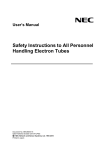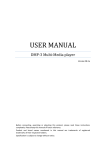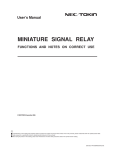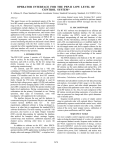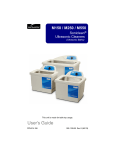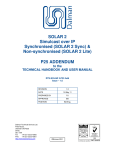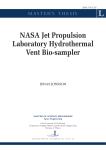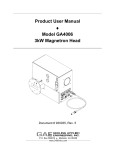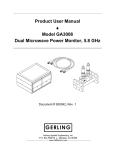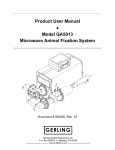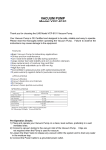Download Safety Instructions to All Personnel Handing Electron Tubes UM
Transcript
User’s Manual Safety Instructions to All Personnel Handling Electron Tubes Document No. ET0048EJ1V1UM00 (1st edition) Date Published February 2002 N CP(N) © Printed in Japan 1997 The information in this document is based on documents issued in December, 2001 at the latest. The information is subject to change without notice. For actual design-in refer to the latest publications of data sheet, etc., for the most up-date specifications of the device. No part of this document may be copied or reproduced in any form or by any means without the prior written consent of NEC Corporation. NEC Corporation assumes no responsibility for any errors which may appear in this document. NEC Corporation does not assume any liability for infringement of patents, copyrights or other intellectual property rights of third parties by or arising from use of a device described herein or any other liability arising from use of such device. No license, either express, implied or otherwise, is granted under any patents, copyrights or other intellectual property rights of NEC Corporation or others. While NEC Corporation has been making continuous effort to enhance the reliability of its e l e c t r o n i c components, the possibility of defects cannot be eliminated entirely. To minimize risks of damage or injury to persons or property arising from a defect in an NEC electronic component, customers must incorporate sufficient safety measures in its design, such as redundancy, firecontainment, and anti-failure features. NEC devices are classified into the following three quality grades: "Standard," "Special," and "Specific". The Specific quality grade applies only to devices developed based on a customer designated "Quality assurance program" for a specific a p p l i c a t i o n . T h e r e c o m m e n d e d applications of a device depend on its quality grade, as indicated below. Customers must check the quality grade of each device before using it in a particular application. Standard: Computers, office equipment, communications equipment, test and measurement equipment, audio and visual equipment, home electronic appliances, machine tools, personal electronic equipment and industrial robots Special: Transportation equipment (automobiles, trains, ships, etc.), traffic control systems, anti-disaster systems, anti-crime systems, safety equipment and medical e q u i p m e n t ( n o t specifically designed for life support) Specific: Aircrafts, aerospace equipment, submersible repeaters, nuclear reactor control systems, life support systems or medical equipment for life support, etc. The quality grade of NEC devices is "Standard" unless otherwise specified in NEC's Data Sheets or Data Books. If customers intend to use NEC devices for applications other than those specified for Standard quality grade, they should contact an NEC sales representative in advance. (Note) (1) "NEC" as used in this statement means NEC Corporation and also includes its majorityowned subsidiaries. (2) "NEC electronic component products" means any electronic component product developed or manufactured by or for NEC (as defined above). DE0102 2 User’s Manual ET0048EJ1V1UM %%$ !" #$%$ &'()* #$%+, ()* - #$%" - #*$*.$ / " / 0(1 / !% 1. PREFACE This document describes safety instructions and general precautions to be taken in using electron tubes. The document also calls attention to handling and use of electron tubes by both users and engineers involved in the design, manufacture and maintenance of microwave equipment. Personnel involved in designing and manufacturing equipment using electron tubes should take protective measures necessary to deal with any conceivable danger. Adequate care should be exercised when using and maintaining such equipment. Read this document in conjunction with the documentation accompanying the product. All personnel should be aware that it is extremely dangerous to take action which voids protective measures for electron tubes described in this document. The user is cautioned not to take such action, but to observe all “CAUTION” labels. 4 User’s Manual ET0048EJ1V1UM 2. GENERAL INFORMATION There are a number of hazards that inevitably occur due to the physical nature of electron tubes. Some electron tubes use materials and chemical substances within them that have adverse impact on the human body. Electron tubes have two failure modes: unexpected events occurring at random and other events occurring towards the end of tube life. These phenomena are found not only in electron tubes, but in all manufactured products. Engineers charged in designing equipment should be knowledgeable and exercise care to provide protection against hazards to personnel as well as equipment. 3. OPERATION 3.1 HIGH VOLTAGE The voltages applied to electron tubes are extremely high which could lead to death if it comes in contact with the human body. All possible measures should be taken to prevent electric shock accident by designing in safety and paying close attention while operating and maintaining the equipment as follows: (1) Since the electron tube is one part of a circuit, the tube should be securely grounded. (2) Equipment should be designed to prevent any operator from coming close to or contacting high-potential electrodes. Interlock, grounding pole, adequate protective cover, etc., must be provided to prevent human contact with high voltage. (3) Make sure to turn off the power switch and ground the high-voltage capacitors with grounding poles before installing or replacing electron tubes. The electron tube may act as a capacitor. Make sure the electron tube is completely discharged before it is handled. Ex: Do not insert a screwdriver in the inlet and output for the tube air-cooling. (4) Make sure to securely connect all cables, connectors and lead wires attached to electron tubes. Incomplete connections may result in over heating, fire or electrical discharge. 3.2 X-RAYS RADIATION X-rays may be generated by an electron tube when a voltage of more than 10 kV is applied. At 20 to 30 kV, soft X-rays having little penetration power are generated and absorbed by the ceramic, glass and metal parts of the vacuum envelope as well as the metal plates used to encase the electron tubes. In practice, no detectable X-rays radiate outside the electron tube voltages less than 20 kV. Attention, however, must be paid to latent X-rays radiating from the tube. The higher the tube voltage and current, the more dangerous the radiation becomes for the human body. Persons designing and manufacturing equipment with voltages higher than 10 kV, must evaluate the level of Xray radiation sufficiently, even though there appears to be no particular indication or warning of the presence of radiation. The amount of X-rays generated varies with the operating mode of electron tubes. Measurement of X- rays under all operating conditions is essential to assure adequate protection. For some tubes operating at 30 kV or higher, such as pulsed klystrons, magnetrons or traveling wave tubes, hard X-rays with greater penetrating power are generated. In such cases, the electron tubes require lead or heavy metal shielding in order to contain the X-rays. In operating or maintaining equipment using electron tubes, make sure to implement the preventative measures specified in the manuals of equipment and electron tubes. Also, consult a specialist concerning the handling of Xrays. User’s Manual ET0048EJ1V1UM 5 3.3 HIGH FREQUENCY RADIATION Electromagnetic waves generate heat as it penetrates matter. Exposure of the human body to such radiation is extremely dangerous, especially the eyes are vulnerable. Looking into the waveguide or coaxial line while the tube is operating, or looking at an antenna directly could expose the eyes to strong radiation resulting in blindness. Never operate an electron tube without connecting a waveguide or coaxial line terminated in an appropriate load. It should be noted that an electron tube may radiate electromagnetic energy with an output circuit that is improperly connected or is loose. Make sure to securely tighten the joints and attach shielding case provided to the electron tube. Do not modify the shape or remove the electromagnetic shielding contacts such as gaskets or contact fingers. Do not remove or reform the shielding case provided to the electron tubes. Appropriate instruments are commonly used to check and measure the level of leakage of electromagnetic field. If such a check is needed, consult with NEC or the equipment manufacturer. 3.4 HIGH TEMPERATURE High-power electron tubes dissipate large amounts of heat which is conducted to the outside by cooling air, water or vapor. During operation, the surface temperature of some parts of the tube may reach as high as 200°C (392°F). Even after turn-off, the tube could still be hot enough to cause a burn if touched. Sufficient time should be allowed before handling the tube. In designing and manufacturing equipment, warning should be clearly shown so that the user does not contact a hot tube. Accidental rupturing or careless opening of the cooling system may release high temperature liquid, steam or vapor which could cause burns to personnel. Devices monitoring the flow or pressure of cooling fluids and safety valves shall be provided. In vapor-cooled electron tubes the temperature of cooling fluid is about 100°C (212°F). In addition, a large amount of calories is present in the cooling chamber. Maximum caution must be taken to prevent contact with the hot vapor when replacing the tube or removing the pipes from the heat exchanger. 6 User’s Manual ET0048EJ1V1UM 4. HANDLING AND STORAGE 4.1 IMPLOSION Electron tubes are high vacuum devices. Thus, the lager the surface area of the vacuum envelope, the greater is the atmospheric pressure applied to the surface. Electrical insulators and if windows, made of glass or ceramic, have less mechanical strength than other metal parts. If these ceramic or glass parts are exposed to physical shock, they could crack or fracture and implode. Implosions are just as dangerous as explosions. In particular, sufficient care should be taken when handling, installing and transporting electron tubes with glass parts that are susceptible to breakage. Large electron tubes having glass bulbs are particularly at risk of imploding if their surface is scratched or strained. Such implosions can lead to injury to personnel from scattering shards of glass and can even cause damage to the respiratory system from minute fragments of glass. In the event of damage to an electron tube, use adequate protection such as thick gloves, protective goggles when handling glass parts; these parts are usually very sharp and can cause injuries. If glass or ceramic parts accidentally break while handling, sprinkle water around the area, if possible, and then use a brush or broom to gently clean up the debris. Never attempt to open or disassemble electron tubes, whatever the kind. Breaking the vacuum of an electron tube will release the pressure applied during the manufacturing process and will result in an implosion. 4.2 BERYLLIA CERAMICS Some electron tubes contain beryllium oxide (BeO), called Beryllia ceramics, in parts such RF windows, attenuators and insulators. Solid pieces of BeO present no danger, as long as they remain whole, however, powder, fumes or vapor of BeO are extremely toxic if inhaled or if it comes in contact with the human body. It can cause pulmonary emphysema, rashes or ulceration. BeO used in electron tubes is sintered at high temperature and will not release powder, fumes or vapor when operated under normal conditions. There is, however, the risk of BeO entering the human body through abrasions, cuts or other external wounds, so do not touch BeO with bare hands. In case BeO is touched, inadvertently, wash the contaminated skin completely with soap and water before drinking, eating or smoking. Never perform mechanical or chemical operations such as breaking, cutting, grinding, applying chemicals, etching or baking on BeO parts. If BeO is accidentally broken while handling, collect fragments into a thick plastic bag, seal the bag tightly with adhesive tape and affix a label clearly indicating “Danger: Beryllium Oxide”. When disposing BeO or electron tubes containing BeO due to end-of-life, damage or malfunction, request the services of a qualified disposal agency or contact NEC. Electron tubes containing BeO parts are marked with a warning label as shown. WARNING CONTAINS BERYLLIA CERAMIC TOXIC DO NOT OPEN TUBE PACKAGE. NEC Corporation 7-1, SHIBA GOCHOME, MINATO-KU, TOKYO 108-01, JAPAN User’s Manual ET0048EJ1V1UM 7 4.3 OTHERS Some electron tubes use powerful permanent magnets for the focusing structure or appendage ion pump. When transporting, moving tubes, maintain a safe distance from the strong magnetic field. Exercise care not to get caught between the tube and part of an equipment or building. When transporting, moving or storing electron tubes, it is recommend that the original shipping container is used. Warning labels are affixed to electron tubes. Some high-power electron tubes are very large and heavy. Make sure to follow the specified method during the moving, transporting and installation of the tube. Handling positions may be designated for some electron tubes. Handling such tube by the incorrect position may result in dropping it due to insufficient mechanical strength. Make sure to handle tubes at the specified locations.








